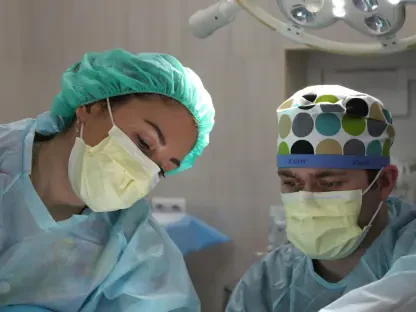In a world where infectious diseases continue to challenge humanity’s resilience, recent breakthroughs and alarming discoveries in public health and virology paint a vivid picture of both progress and peril that demands our attention. From the transformative power of mRNA vaccines that have saved millions of lives to a potential new treatment for a stubborn sexually transmitted infection, and the unsettling spread of avian flu to the remote icy shores of Antarctica, these developments underscore the complexity of global health. Each story reveals a unique facet of the ongoing battle against disease, highlighting the interplay between cutting-edge science, policy decisions, and nature’s unpredictability. As scientists and health experts navigate these challenges, the stakes remain high, demanding innovation, collaboration, and vigilance to protect populations across urban centers and untouched wilderness alike. This exploration delves into the latest updates on these critical fronts, shedding light on what they mean for the future of health security on a global scale.
The significance of these topics extends beyond isolated incidents, reflecting broader trends in how society responds to health threats. The debate over mRNA technology showcases the tension between scientific achievement and public perception, while a novel antibiotic offers hope against the growing menace of drug resistance. Meanwhile, the detection of avian flu in one of the planet’s most isolated regions serves as a stark reminder of disease’s boundless reach. Together, these narratives emphasize the urgency of staying ahead through research and international cooperation. Let’s unpack each of these pressing issues to understand their implications and the responses they’ve sparked among experts and policymakers worldwide.
Pioneering Vaccine Technology Under Scrutiny
Global Endorsement Amidst Local Pushback
The realm of vaccine development has been revolutionized by mRNA technology, a tool that has proven its worth in preventing millions of deaths during global health crises. Supported by an extensive network of over 80 research labs across 40 countries through the Global Virus Network, this platform is lauded for its rapid adaptability to emerging viral threats. Data reveals that mRNA-based solutions have averted an estimated 7.5 million deaths worldwide during past pandemics, with adverse reactions reported in less than 1% of recipients after hundreds of millions of doses. However, in the United States, a surprising policy shift has halted further research into this technology, drawing sharp criticism from scientists who argue that such a move undermines national preparedness for future outbreaks. This divergence between international acclaim and domestic resistance highlights a critical rift in public health strategy, raising questions about how to align scientific evidence with political will.
This controversy is not merely a matter of policy but a reflection of deeper societal divides that could shape health outcomes for years to come. The decision to pause mRNA projects in the U.S. has been met with concern from global health advocates who fear it may slow down the momentum of innovation at a time when agility is paramount. Experts point out that the technology’s success in reducing death rates by approximately 90% during severe viral waves demonstrates its indispensable role. The international scientific community remains steadfast, urging a unified approach to sustain advancements and ensure that such tools remain accessible, especially in regions most vulnerable to infectious diseases. Bridging this gap between global consensus and localized skepticism will be essential to maintaining trust and efficacy in vaccination efforts moving forward.
Future Potential and the Fight Against Misinformation
Looking beyond its current applications, mRNA technology holds immense promise for addressing a wide array of health challenges, from tropical diseases like Zika to complex conditions such as cancer through immunotherapy. Research initiatives spanning multiple continents are actively exploring these possibilities, with scientists emphasizing the platform’s versatility as a cornerstone of modern medicine. The potential to tailor responses to high-consequence pathogens positions this innovation as a game-changer in public health. Yet, the path forward is not without obstacles, as political rhetoric and misinformation, often amplified through public platforms, threaten to erode confidence in these advancements. In certain U.S. circles, vocal criticism from health officials has fueled debates that contrast sharply with the data-driven endorsements from global experts, creating a challenging landscape for progress.
Combating misinformation requires more than just presenting facts; it demands a concerted effort to engage communities and foster transparency about the safety and benefits of mRNA solutions. The international health community advocates for educational campaigns to counter false narratives, stressing that public trust is as vital as the technology itself. Moreover, expanding access to these vaccines in low- and middle-income countries remains a priority to address global health inequities. As research continues to push boundaries, the focus must also be on building a robust dialogue with the public to ensure that fear and misunderstanding do not overshadow the life-saving potential of this scientific breakthrough. Only through such collaborative and open strategies can the full scope of mRNA’s impact be realized.
A Promising Advance in Antibiotic Development
A New Weapon Against a Growing Threat
In the ongoing struggle against antibiotic resistance, a significant stride has been made with gepotidacin, an oral antibiotic under priority review by the U.S. Food and Drug Administration for treating uncomplicated gonorrhea. This sexually transmitted infection affects over 82 million individuals globally each year, and the rise of drug-resistant strains has left few effective options. Clinical trials involving over 600 participants across multiple countries have shown gepotidacin achieving a 93% success rate with just two oral doses, matching the efficacy of the current standard treatment that requires an injection paired with another drug. This development promises not only effectiveness but also greater accessibility, particularly for patients in regions where injectable treatments are less feasible due to logistical barriers.
The implications of this breakthrough extend far beyond individual patient outcomes, addressing a pressing public health crisis that has been escalating for decades. Gonorrhea’s ability to develop resistance to nearly every antibiotic used against it has alarmed organizations like the World Health Organization and the Centers for Disease Control and Prevention, which classify it as an urgent threat. The potential approval of gepotidacin could mark the first new oral treatment for this infection in decades, offering a lifeline where existing therapies are failing. Supported by public-private partnerships, this innovation reflects a broader commitment to tackling antimicrobial resistance through targeted research and development, ensuring that solutions reach those most in need across diverse populations.
Wider Impacts on Health Systems
The introduction of gepotidacin could fundamentally reshape the approach to managing gonorrhea, particularly in preventing severe complications such as infertility and pelvic inflammatory disease that arise from untreated cases. Current treatments, often reliant on ceftriaxone, face challenges not only from resistance—already widespread in parts of Asia—but also from accessibility issues due to their injectable nature. An oral alternative stands to simplify administration, potentially increasing compliance and reducing the burden on healthcare systems. This advancement aligns with global health priorities to curb the spread of resistant bacteria, a problem that complicates treatment across many infectious diseases and poses a significant risk to modern medical practices like surgeries and cancer therapies.
Beyond the immediate benefits for gonorrhea patients, this development underscores the critical need for sustained investment in antibiotic innovation to stay ahead of evolving pathogens. The collaboration behind gepotidacin, involving governmental bodies and pharmaceutical expertise, serves as a model for addressing other resistant infections that threaten global health security. As resistance continues to outpace the development of new drugs, such initiatives highlight the importance of proactive strategies and international cooperation. If approved, this treatment could pave the way for similar efforts, reinforcing the urgency of integrating new tools into public health frameworks to protect vulnerable communities and maintain the efficacy of medical interventions worldwide.
Emerging Disease Risks in Remote Regions
Unprecedented Findings in a Pristine Environment
Turning to one of the planet’s most isolated regions, the detection of suspected H5 highly pathogenic avian influenza virus in Antarctic seabirds marks a concerning milestone in the global spread of this disease. Recent surveys conducted by Chilean researchers identified potential infections in nine birds, including Adelie penguins and an Atlantic cormorant, primarily near the northeastern Antarctic Peninsula. This is the first suspected presence of the virus in such a remote ecosystem, linked to the rapid expansion of a specific viral clade through migratory bird movements. The absence of clinical symptoms in the affected birds adds a layer of complexity to surveillance efforts, as it suggests subclinical infections that could go unnoticed without rigorous testing.
The significance of this discovery lies in its potential to disrupt Antarctica’s delicate ecological balance, a region previously untouched by such pathogens. The virus’s arrival, likely facilitated by birds migrating from areas like Chile where it was detected a few years ago, illustrates the far-reaching impact of global wildlife movements. Researchers warn that this could signal the addition of new species to the list of affected wildlife, expanding the virus’s footprint in an area critical for biodiversity. Heightened monitoring is now essential to determine the scope of spread and to prevent further ecological consequences in this pristine environment, where even small disturbances can have outsized effects on native populations.
Broader Risks and the Call for Vigilance
While the immediate impact of avian flu in Antarctica appears limited to wildlife, the broader implications for global health cannot be ignored, as zoonotic diseases have the potential to cross species barriers and affect human populations. The geographic distribution of the suspected cases, confined to specific islands rather than widespread across the continent, offers some reassurance but does not diminish the need for caution. The silent nature of these infections, with birds continuing to forage normally, complicates efforts to track and contain the virus, underscoring the challenges of monitoring diseases in remote and harsh environments. International scientific teams are advocating for expanded research to understand transmission dynamics and assess risks to other species in the region.
This situation also highlights the interconnectedness of human, animal, and environmental health under the One Health framework, emphasizing that diseases in wildlife can have cascading effects. The spread of avian flu to such an isolated area serves as a stark reminder of how ecological factors and global migration patterns drive emerging threats. As surveillance intensifies, the focus must be on developing strategies to mitigate risks not only to Antarctic ecosystems but also to prevent potential spillover events elsewhere. Collaborative efforts across nations and disciplines will be crucial to address these challenges, ensuring that early warnings translate into effective responses before such threats escalate into larger crises.
Shared Challenges and Future Directions
Harnessing Science for Collective Good
Across the diverse landscapes of public health, a common thread emerges in the form of scientific innovation driving solutions to complex problems, whether through mRNA vaccine platforms, novel antibiotics, or advanced disease monitoring in remote regions. Each advancement, from the global endorsement of cutting-edge vaccine technology to the development of gepotidacin for resistant infections and the detection of avian flu in Antarctica, relies on a foundation of rigorous research and international collaboration. These efforts reflect a shared commitment to preempting health crises, demonstrating that no single nation or entity can tackle such multifaceted threats alone. The synergy of expertise and resources across borders remains a linchpin in addressing pandemics, antimicrobial resistance, and zoonotic risks that transcend geographic boundaries.
The success of these initiatives also hinges on translating scientific progress into tangible benefits for all populations, particularly those most at risk. The push to expand access to vaccines and treatments in underserved areas, alongside the need for real-time surveillance in ecologically sensitive zones, underscores the importance of equity in health responses. As these stories illustrate, innovation is only as effective as the systems that deliver it, requiring robust infrastructure and partnerships to ensure that breakthroughs reach the front lines of need. Moving forward, sustaining this momentum will depend on continued investment in research and a collective resolve to prioritize health as a global public good, bridging gaps between discovery and implementation.
Overcoming Obstacles Through Unified Action
Despite the promise of scientific advancements, significant barriers persist, including misinformation surrounding vaccine technologies, policy resistance that delays critical research, and logistical hurdles in delivering treatments or monitoring diseases in hard-to-reach areas. The tension between evidence-based consensus and public or political skepticism, evident in the U.S. stance on mRNA projects, mirrors challenges in ensuring equitable access to new antibiotics for infections like gonorrhea. Similarly, the logistical complexities of tracking avian flu in Antarctica highlight the difficulties of addressing threats in remote environments. These obstacles reveal that scientific solutions alone are insufficient without strategies to build trust and facilitate access across diverse contexts.
Reflecting on past efforts, the global health community recognizes that overcoming such challenges demands a unified approach, integrating communication, policy alignment, and resource sharing to turn potential into progress. Looking ahead, actionable steps include fostering public dialogue to counter misinformation, advocating for policies that support innovation, and strengthening international networks for disease surveillance and treatment distribution. By addressing these barriers head-on, the lessons learned from recent developments can guide future responses, ensuring that the fight against infectious diseases remains proactive and inclusive. The path forward lies in leveraging collaboration to transform challenges into opportunities for a healthier, more resilient world.









